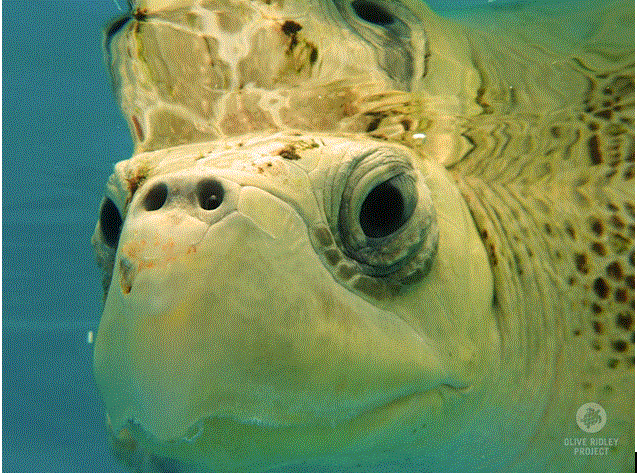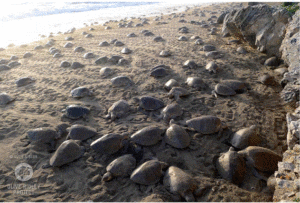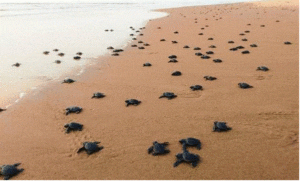Travel in India
A Rapturous welcome @ Gahirmatha Beach: Olive Ridley Turtle

Reptiles are always an exceptional class of animal kingdom. It certainly creates curiosity, fright, familiarity and above all admiration for its limiting attributes. The taxonomy of the animal kingdom could not be completed without the experience of class Reptilia. Be it a dreadful snake or silent killer cumbersome crocodile or lethargic elegant turtle, all leave an indelible scar in the fragile memory of philotherianism. Oliver ridley turtle is such innocuous and exceptional species which captures the imaginations of herpetologist when they arrived at sea coast searching for their breeding destiny. Gahrimatha is a place at the confluence of the bay of Bengal and Brahamani river in the Kendrapada district of littoral state Odisha. The picturesque bucolic beach gives sightseers immense reason to visit once in their life. In the advent of winter, lakhs of turtle colored the sea beaches with their rugged morphology.
Olive Ridley Turtle
The olive ridley sea turtle Taxonomically named as Lepidochelys olivacea and it belongs to class reptilia with thousands of individual. It is mainly confined to Pacific and Indian Ocean with northern tropical warm waters. Hence it is otherwise termed as the Pacific ridley sea turtle. According to IUCN Olive ridley place under vulnerable (VU) group. Its story began in 1758 as Testudo Mydas. These are best known for their mass nesting and nestling called arribada. Arribada is the place where thousands of female come together towards the same beach to lay eggs.
Structure
- Sexual Dimorphism is found in an adult case
- Olive colored carapace (Heart shaped)
- Creamy white plastron.
- Male and female ground to the same size.
- Rounded carapace in the female.
- Carapace (Olive in color) is dorsally flattened.
- Carapace became reddish due to algae growing on the carapace.
- Weight = 50 kg -52 kg (Rare) ,25-45 kg-Female,33 kg Male
- Hatchling-12-23.5 gm
- Tail used for copulation(reproduction)
Feeding
The olive ridley is predominantly carnivorous, especially in immature stages of the lifecycle. Animal prey consists of protochordates or invertebrates, which can be caught in shallow marine waters or estuarine habitats. Common prey items include jellyfish, tunicates, sea urchins, bryozoans, bivalves, snails, shrimp, crabs, rock lobsters, and sipunculid worms. Additionally, consumption of jellyfish and both adult fish (e.g. Sphoeroides) and fish eggs may be indicative of pelagic (open ocean) feeding. The olive ridley is also known to feed on filamentous algae in areas devoid of other food sources. Captive studies have indicated some level of cannibalistic behavior in this species.
Migration
The olive ridley is best-known individuals for migration (Cyclical, seasonal, intentional). The convention on migratory species also provided a source of knowledge about this marine turtle. They focus Arribada management for conserving olive ridleys. Mostly ridleys migrate towards the nesting beach of Gahiramatha. This beas separates the Bhitarakanika mangroves from the Bay of Bengal. It is the part of (GMWS) Gahiramatha marine wildlife sanctuary. It is the part of Gahirmatha Marine Wildlife Sanctuary. It is otherwise known as Gahirmatha rookery (Natal nesting beach) other sports of mass nesting-mouth of Rivers Devi and Rushikulya.
Reproduction
Mating is often assumed to occur in the vicinity of nesting beaches, but copulating pairs have been reported over 1,000 km from the nearest beach.
Research from Costa Rica revealed the number of copulating pairs observed near the beach could not be responsible for the fertilization of the tens of thousands of females, so a significant amount of mating is believed to have occurred elsewhere at other times of the year.
Olive ridleys generally begin to aggregate near nesting beaches about two months before nesting season, although this may vary throughout their range. In the eastern Pacific, nesting occurs throughout the year, with peak nesting events (arribadas) occurring between September and December. Nesting beaches can be characterized as relatively flat, mid-beach zone, and free of debris. Beach fidelity is common, but not absolute. Nesting events are usually nocturnal, but diurnal nesting has been reported, especially during large arribadas. The exact age of sexual maturity is unknown, but this can be somewhat inferred from data on minimum breeding size. For example, the average carapace length of nesting females (n = 251) at Playa Nancite, Costa Rica, was determined to be 63.3 cm, with the smallest recorded at 54.0 cm. Females can lay up to three clutches per season, but most only lay one or two clutches. The female remains near shore for the inter-nesting period, which is about one month. Mean clutch size varies throughout its range and decreases with each nesting attempt.
Mean clutch size of 116 (30–168 eggs) was observed in Surinam, while nesting females from the eastern Pacific were found to have an average of 105 (74–126 eggs). The incubation period is usually between 45 and 51 days under natural conditions but may extend to 70 days in poor weather conditions. Eggs incubated at temperatures of 31 to 32 °C produce only females; eggs incubated at 28 °C or less produce solely males, and incubation temperatures of 29 to 30 °C produce a mixed-sex clutch. Hatching success can vary by beach and year, due to changing environmental conditions and rates of nest predation.

Exploitation
The olive ridley has been exploited for various purposes. It can be food, oil, leather, egg, meat or fertilizer. The egg is esteemed everywhere due to its negative delicaly. Gahiramatha is the largest breeding ground of Oliver ridley turtle. Collection of eggs is illegal but these laws are rarely enforced. Costa Rica is famous for turtle exploitation as it is economically viable. Illegal poaching of eggs is considered a major threat to the olive ridley population. This is the major issue which attracts the conservationist and biologist to put steps forward.
Welcome @ Gahirmatha Beach
Gahirmatha Beach is a beach in the Indian state of Odisha. The beach separates the Bhitarkanika mangroves from the Bay of Bengal and is the world’s most important nesting beach for Olive Ridley Sea Turtles. The beach is part of Gahirmatha Marine Wildlife Sanctuary, which also includes the adjacent portion of the Bay of Bengal.

The Gahirmatha Beach in Kendrapara district of Odisha (India), which is now a part of the Bhitarkanika Wildlife Sanctuary, is the largest breeding ground for these turtles. The Gahirmatha Marine Wildlife Sanctuary, which bounds the Bhitarkanika Wildlife Sanctuary to the east, was created in September 1997 and encompasses Gahirmatha Beach and an adjacent portion of the Bay of Bengal. Bhitarkanika mangroves were designated a Ramsar Wetland of International Importance in 2002. It is the world’s largest known rookery of olive ridley sea turtles. Apart from Gahirmatha rookery, two other mass nesting beaches have been located, which are on the mouth of rivers Rushikulya and Devi. The spectacular site of a mass congregation of olive ridley sea turtles for mating and nesting enthralls both the scientists and the nature lovers throughout the world.
Olive ridley sea turtles migrate in huge numbers from the beginning of November, every year, for mating and nesting along the coast of Orissa. Gahirmatha coast has the annual nesting figure between 100,000 and 500,000 each year. A decline in the population of these turtles has occurred in the recent past due to mass mortality. The olive ridley sea turtle has been listed on Schedule – I of the Indian Wildlife (Protection) Act, 1972 (amended 1991). The species is listed as vulnerable under IUCN. The sea turtles are protected under the ‘Migratory Species Convention’ and Convention of International Trade on Wildlife Flora and Fauna (CITES). India is a signatory nation to all these conventions. The homing characteristics of the Ridley sea turtles make them more prone to mass casualty. The voyage to the natal nesting beaches is the dooming factor for them. Since Gahirmatha coast serves as the natal nesting beach for millions of turtles, it has immense importance on turtle conservation.
Gahirmatha beach is incidentally acclaimed as world’s largest-known nesting ground of these animals. Apart from Gahirmatha, these threatened aquatic animals turn up at Rushikulya river mouth and Devi river mouth for mass nesting. An estimated 6.57 lakh female turtles had turned to dig a pit and lay millions of eggs on the nesting beach during March this year. Fishing prohibition is presently clamped in Gahirmatha zone to ensure disturbance-free mating of the marine animals. After the end of the mating season, most of the male turtles usually return back leaving behind the female turtles to lay their eggs. The female turtles virtually invade the nesting beaches usually at the dead of the night for laying eggs, the phenomenon is described as “arribada”. After indulgence in instinctive egg-laying, the turtles leave the nesting ground to stride into the deep sea water. Hatchlings emerge from these eggs after 45-60 days. It is a rare natural phenomenon where babies grow without their mother. The ban on sea fishing remains in force around the year in Gahirmatha marine sanctuary as the seawater here is the most conducive habitat for these delicate marine species.
The rate of mortality of these endangered species is quite high. An olive ridley usually lays about 120 to 150 eggs from which hatchlings emerge after about 45 to 60 days. But not all eggs remain intact as predators devour it.
Ecological Essence
A unique query always comes to the ordinary citizen of the nation that what they do for us? According to WWF(World wildlife) sources, turtles are great scavengers, the garbage patrol of an area, and eating up dead fish from lakes and rivers. They do no harm and they do a lot of good. Turtles also provide homes for a lot of critters. Burrows dug by gopher tortoises shelter over 350 species, including burrowing owls, rabbits, and bobcats. Turtles are even bio-engineers, keeping the landscape healthy and varied by dispersing seeds.
A box turtle that eats some strawberries and then walks half a mile and defecates the seeds is adding to the landscape. They also rotate including the sand on the sea floor, and redistributing energy from one ecosystem to another. Nesting sea turtles leave about 75 percent of their energy on land in the form of eggs and hatchlings before they return to sea. So, turtles do a lot for the world’s ecology.
What else would we lose? An absence of turtles would be a “cultural, psychological loss,” to many societies. We revere their traits of persistence and serenity. They’re the one reptile that just about everyone likes.

This beautiful article on Olive Ridley Turtles has been co-authored by Lipsa Das, dedicated and compassionate teaching professional. She specializes in the field of Life Sciences especially Zoology. She is a lecturer in Zoology with specialization in Cell Biology and Biochemistry from North Orissa University. She has completed her M.Sc., M.Phil and pre Ph.D. coursework from the same university. Teaching is her passion as well as profession. She is very much committed to the field of research and it’s application towards society. As a member of the animal kingdom, her foremost aim is to protect nature and it’s biotic factors. As a lecturer, she tries to inculcate an inventive attitude in her students. She is convinced that in order to protect the mother earth, this thought needs to first germinate and take shape in our mind.






























Subharaj Panda
June 6, 2019 at 8:01 AM
Your research work really gives very much informational data about living creatures…
I hope your next post will be more special.
Sherlock Holmes
June 6, 2019 at 11:50 AM
We r arguably greatest, cleverest and most powerful creation ..How far this statement is true,God knows … We can’t provide a better environment,eco system to smaller and less evolved animal .. It’s a shame on our society .. save animal ,save the nature
Swasti asundar Mohapatra
June 6, 2019 at 12:00 PM
Your act of writing skill about the living world is always fantastic and authentic ever.
Sarada
June 6, 2019 at 12:02 PM
Thanks for valuable suggestion. I will try my best to live up to your expectations.
Prasanta Kumar behera
June 6, 2019 at 12:28 PM
This is the only speciality of a science student who any Where,any thing can write in a systematic way with a perfect representative artistry.
Prasanta Kumar behera
June 6, 2019 at 12:30 PM
This is the only speciality of a science student who any Where,any thing can write in a systematic way with a perfect representative artistry
Basanta
June 6, 2019 at 7:02 PM
Such a awesome topic u have discussed here, Thank u